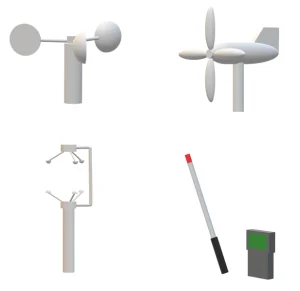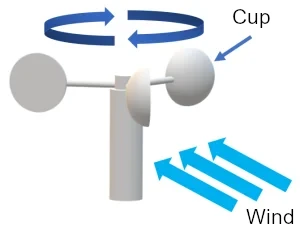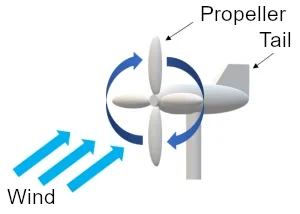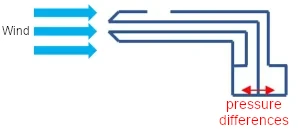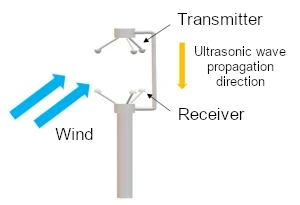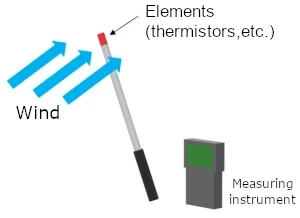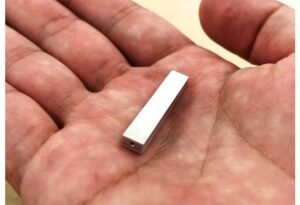In the daily weather forecast, they report the direction in which the wind blows, such as “north wind 3 meters” or “southeast wind 5 meters,” and the x meters speed (strength) of the wind.
This x meters is more accurately “x meters per second [m/s],” which represents the distance that the wind travels in one second.
The device that measures this wind speed is called an anemometer or a wind speed sensor, and since wind, i.e. air flow, is invisible to the eye, it is measured using a special device.
This section introduces the types of anemometers and wind speed sensors.
Types of anemometers and wind speed sensors
There are several types of wind speed sensors. Based on the principle of measurement, the following types are available.
- – Rotating: Cup and windmill
- – Wind pressure: Pitot tube
- – Ultrasonic: Ultrasonic
- – Thermal: Hot-wire
There are finer distinctions, but these are the four typical ones.
Next, here are the characteristics of each of them.
Rotating wind speed sensor
Cup wind speed sensor
The cup wind speed sensor consists of two or more bowl-like objects (called cups), connected by a rod-like object and supported by a central axis.
The wind that blows in the direction of the opening of the cup pushes the cup harder than the wind that blows in the direction of the curved part of the cup, so the cup spins around.
Since this rotation speed is proportional to wind speed, this simple wind speed sensor can measure wind speed by reading the rotation speed.
This sensor has long been used in combination with an anemometer for weather observation and other applications.
Windmill wind speed sensor
A windmill wind speed sensor consists of a propeller like an airplane and a shaft that supports the body and can rotate.
When the wind blows, the wind resistance to the body causes the propeller to turn in the direction of the wind and rotate in proportion to the wind speed.
By reading this rotation speed, wind speed can be measured.
It also features the ability to measure wind direction by the direction the propeller is facing.
This sensor is mainly used for weather observation.
Wind pressure wind speed sensor
Pitot tube wind speed sensor
The pitot tube wind speed sensor consists of two tubes, an inner and an outer tube. The inner tube is perforated so that it is perpendicular to the wind, and the outer tube is perforated on the side so that the wind traces through it, and each tube has a pressure gauge.
Since the difference in pressure at the base of these two tubes is proportional to wind speed, wind speed can be measured by measuring this pressure.
Since pressure differences are difficult to generate at low wind speeds and a certain amount of wind speed is required, it is used to measure the speed of airplanes flying at high speeds.
Ultrasonic wind speed sensor
An ultrasonic wind speed sensor consists of a transmitter that emits ultrasonic waves and a receiver that receives them.
Since the propagation time of ultrasonic waves is affected by the wind speed, the wind speed is measured based on the propagation time.
Wind direction can also be measured from propagation time figures to multiple receivers, and there are no moving or electrically exposed parts, making the sensor exceptionally durable.
Due to the complexity of the mechanism, they tend to be more costly.
Hot-wire wind speed sensor
A hot-wire wind speed sensor measures wind speed by applying an electric current to a platinum wire, nichrome wire, or thermistor to generate heat, and then measuring the temperature when the heat has been cooled by the blowing wind.
It has no moving parts, making it durable and suitable for measurement at low wind speeds.
This sensor is widely used as a wind speed sensor for industrial applications due to its cost and performance.
The following table summarizes the characteristics of the wind speed sensors introduced above.
| Characteristics |
Cup |
Windmill |
Pitot tube |
Ultrasonic |
Hot-wire |
| Principle of measurement |
Rotation speed of cup |
Rotation speed of windmill |
Relation between pressure difference and wind speed |
Propagation speed of ultrasonic waves |
Cooling effect of hot wire |
| Measurement range |
Medium speed |
Medium speed |
High speed |
Low speed to high speed |
Low speed to medium speed |
| Measurement of wind direction |
No |
Yes |
No |
Yes |
No |
| Cost |
Low to medium |
Low to medium |
High |
High |
Low to medium |
What do you think?
Each has its own characteristics, and we recommend that you choose the one that best suits your application.
Now we will introduce you to the “compact wind speed sensor” developed by SEMITEC.
SEMITEC’s “compact wind speed sensor”
The anemometers and wind speed sensors introduced so far are mainly used for weather observation and installed both indoors and outdoors.
Therefore, they are generally not compact enough to be integrated into equipment.
SEMITEC’s compact wind speed sensor is classified as a thermal wind speed sensor. The sensor element was made using a microfabrication technique called silicon micromachining.
This is a high-performance wind speed sensor that is not only easy to integrate into equipment due to its very compact size, but also responds to wind speed agilely, with a response time of several tens of milliseconds.
Furthermore, SEMITEC’s unique mechanism makes the sensor resistant to dust, moisture, and other harsh environments.
It is also suitable for wind measurement for air conditioners, hair dryers, and other electrical appliances, and for use on drones.
By preparing different attachments for the wind intake part of the sensor, it can be used for various applications.

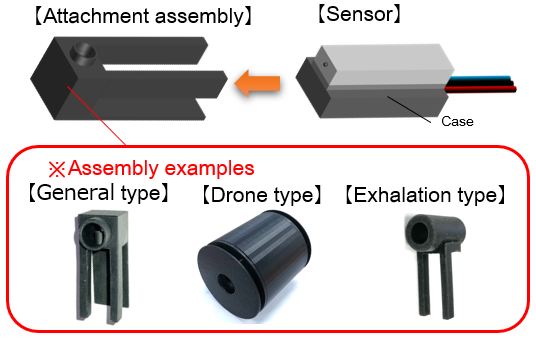
Can be used for various applications by changing attachments.
For example, wind flow is often irregular. When accurately measuring wind speed in a certain direction, a directional attachment is needed.
In addition, in order to measure slight wind speeds that cannot be felt by humans, an attachment with enhanced sensitive wind speed measurement is required.
Directional wind speed sensor
Directional wind speed sensors are for measurement in the medium wind speed range (10 m/s or less), and are compact and capable of fast response.
It is directional, so it can selectively measure wind speed in one direction.
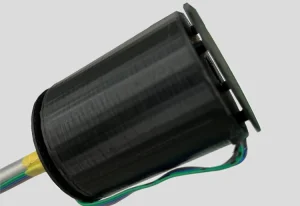
Directional wind speed sensor
Sensitive wind speed sensor
The
Low wind speed sensor is designed for detection in the slight wind speed range (1 m/s or less).
Capable of sensing wind speeds that are too small to be detected by humans, it is ideal for wind speed monitoring of local exhaust systems, air-cooling equipment, and air-conditioning equipment.
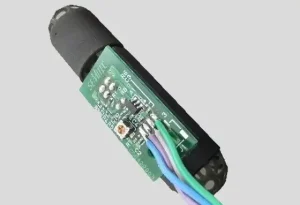
Low wind speed sensor
Please contact us if you have any questions about potential applications or anything else.
Click here to Contact form

